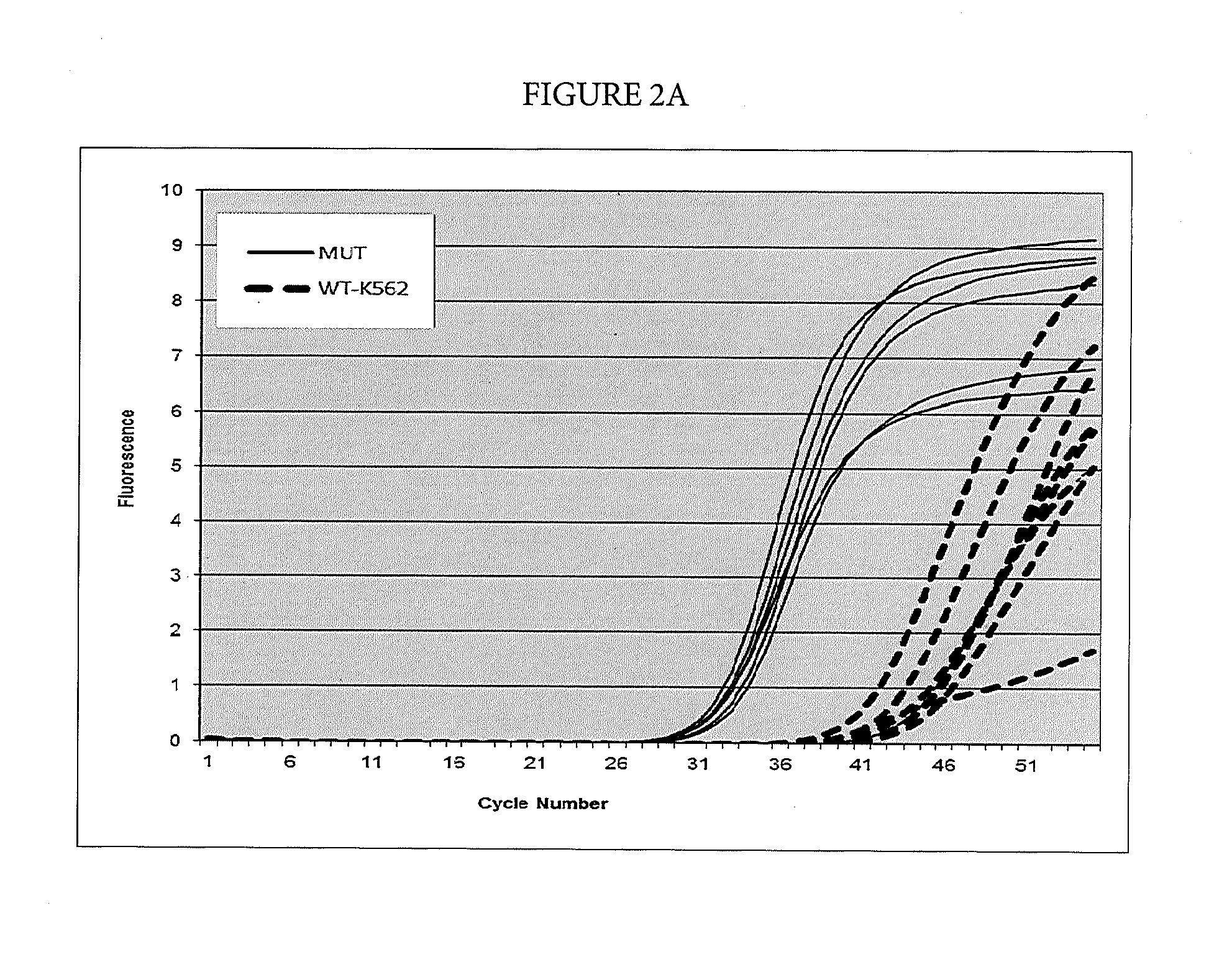Suppression of non-specific amplification with high-homology oligonucleotides
a technology of high-homology oligonucleotide and non-specific amplification, which is applied in the field of suppression of non-specific amplification with high-homology oligonucleotides, can solve the problems of misdirecting the patient's therapy, the inability to achieve ideals, and the inability to completely avoid amplification of non-target sequences, so as to reduce non-specific amplification
- Summary
- Abstract
- Description
- Claims
- Application Information
AI Technical Summary
Benefits of technology
Problems solved by technology
Method used
Image
Examples
example 1
Suppression of Breakthrough Amplification by a PCR Primer
[0071]In this example, suppression of breakthrough amplification was observed in an AS-PCR targeting mutations in codon 12 of the human NRAS gene. The primers and probes used in Example 1 are shown in Table 2. An upstream primer selected from among SEQ ID NOs: 6-23 is matched to one of the mutations 35G>C, 34G>T, 35G>A, 34G>C, 34G>A, and 35G>T corresponding to amino acid changes G12A, G12C, G12D, G12R, G12S, and G12V in exon 2 of the human NRAS gene and is mismatched with the wild-type sequence. A downstream primer selected from SEQ ID NOs: 24-26 is common between the mutant and wild-type sequences of exon 2 in the human NRAS gene and the detection probe is selected from SEQ ID NOs: 27-29.
[0072]
TABLE 2Primers and probes for exon 2 of the NRAS gene used in Example 1.SEQ ID NO:FunctionSequence 5′-3′SEQ ID NO: 635G > C AS primerCTGGTGGTGGTTGGAGCCGCSEQ ID NO: 735G > C AS primerCTGCTGGTGGTTGGAGEAGCSEQ ID NO: 835G > C AS primerCTGCT...
example 2
Suppression of Breakthrough Amplification by an Additional Suppressor Oligonucleotide
[0075]In this example, suppression of breakthrough amplification was observed in an AS-PCR targeting mutations in codon 61 of the human NRAS gene. The primers and probes used in Example 2 are shown in Table 3. An upstream primer selected from among SEQ ID NOs: 30-47 is matched to one of the mutations 183A>T, 183A>C, 181C>A, 182A>T, 182A>C, 182A>G corresponding to amino acid changes Q61Ha, Q61Hb, Q61K, Q61L, Q61P, and Q61R in the human NRAS gene and is mismatched with the wild-type sequence. A downstream primer selected from among SEQ ID NOs: 48-50 and detection probe selected from among SEQ ID NOs: 51-53 are common between the mutant and wild-type sequences in exon 3 of the NRAS gene. Suppressor oligonucleotides selected from among SEQ ID NOs: 1-5 do not hybridize to any of the amplicons defined by the primer pairs used in this example.
[0076]
TABLE 3Primers and probes for exon 3 of the NRAS gene used...
example 3
Suppression of Breakthrough Amplification of the Unrelated Template PI3KCA by a Suppressor Oligonucleotide
[0079]In this example, suppression of breakthrough amplification was observed in an AS-PCR targeting mutations in codon 1049 of the human PI3KCA gene. The primers and probes used in Example 3 are shown in Table 4. An upstream primer selected from among SEQ ID NOs: 54-56 is matched to the mutation 3145G>C corresponding to the amino acid change G1049R in the human PI3KCA gene and is mismatched with the wild-type sequence. A downstream primer selected from among SEQ ID NOs: 57-59 and a probe selected from among SEQ ID NOs: 60 & 96 and 61 & 97 are common between the mutant and wild-type sequences. Suppressor oligonucleotides selected from among SEQ ID NOs: 1-5 (specific for the human NRAS gene) do not hybridize to the PI3KCA amplicons used in this example.
[0080]
TABLE 4Primers and probes for the PI3KCA gene used in Example 3.SEQ ID NO:FunctionSequence 5′-3′SEQ ID NO: 543145G > C AS p...
PUM
| Property | Measurement | Unit |
|---|---|---|
| temperature | aaaaa | aaaaa |
| size | aaaaa | aaaaa |
| concentration | aaaaa | aaaaa |
Abstract
Description
Claims
Application Information
 Login to View More
Login to View More - R&D
- Intellectual Property
- Life Sciences
- Materials
- Tech Scout
- Unparalleled Data Quality
- Higher Quality Content
- 60% Fewer Hallucinations
Browse by: Latest US Patents, China's latest patents, Technical Efficacy Thesaurus, Application Domain, Technology Topic, Popular Technical Reports.
© 2025 PatSnap. All rights reserved.Legal|Privacy policy|Modern Slavery Act Transparency Statement|Sitemap|About US| Contact US: help@patsnap.com



